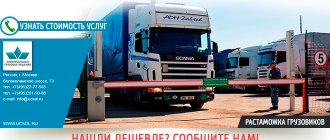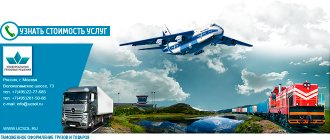The cost of customs clearance of cargo depends on numerous factors:
- Type of goods passing through customs;
- Type of transportation (import/export);
- Number and type of required customs procedures;
- The client’s status as a participant in foreign trade activities;
- Region of customs activity.
This is only a small part of the factors that are taken into account when calculating the final cost of customs services. No customs broker or transport company can indicate the final price for its services without information about the cargo, its route and other conditions of transportation.
Transportation and customs clearance of personal belongings
The question of delivery of personal belongings or other property from abroad may arise unexpectedly, because a business trip or moving to a new place of residence often involves such a procedure. To do this, most people are looking for a suitable company by the appropriate name, but, in addition, they are also interested in significant nuances, for example, the cost of delivery services provided, paperwork for customs authorities , the procedure itself and the timing of delivery of their cargo .
Customs clearance of individuals
Several available companies that can provide services both for the transportation itself and for the preparation of all documents required on the road for the transportation of goods are suitable for the corresponding request. To ensure peace of mind for the client, such carriers take full responsibility and are ready to provide valid guarantees that meet all customs requirements and facilitate the fast and high-quality movement of cargo from one state to another.
The staff of such carriers are specialists with extensive experience in this area of transportation, so they will be able to efficiently resolve any issue, as they do this every day. Therefore, the experts of the Standard Group company can easily assess the complexity of each specific transportation, advise on the procedure for registering all the necessary things and valuables, and also provide services for registering things when entering or leaving another country.
What determines the cost of customs clearance of cargo and goods?
You can derive the basic formula:
The price of customs clearance of goods = customs duties + fees + VAT.
- Type of cargo and characteristics of the goods.
The type and classification of goods determines the amount of customs duties, which are determined in accordance with the HS code, the amount of VAT (a reduced tax rate is provided for the import/export of some types of goods), and the amount of customs duties. Depending on the type of cargo, different preferences may apply.
- Type of cargo transportation.
Export and import are subject to different customs fees and duties, and different documentation is required.
- Number and type of customs procedures.
The complex price of cargo clearance at customs is also affected by the number of customs procedures that must be completed. These include import/export clearance, processing, temporary importation, re-import/re-export, certification, etc. Often additional services of a customs broker, placement of cargo in a temporary storage warehouse, cargo processing, etc. are required.
- Region of customs activity.
Tariffs for customs clearance depend on which customs office the cargo passes through. For example, customs at Domodedovo airport and customs in the Moscow region are different organizations with different competencies.
- Foreign trade participant status.
Different duties and fees are provided for legal entities and individuals.
Customs clearance rules for individuals
The most interesting thing is that delivery of personal belongings is possible from the client’s porch in one state to the door at his new place of residence. Thus, the Standard Group company guarantees a complete security package for transportation; the client only needs to sign the necessary documents and powers of attorney. Packing, shipping, loading and unloading is no longer a headache. With the well-established scheme of large companies, the service is provided with high quality, the deadlines are as short as possible, and the prices are more affordable.
This approach allows a person to live as usual, following his schedule and not experience headaches and emotional shock from the upcoming red tape. In turn, some companies understand that a client may need the services of a lawyer while in another state, so they are willing to provide this opportunity for an appropriate fee. Experts from the customs and logistics company Standard Group +7 (499) 490-66-68 will help you formalize and go through all procedures related to customs and border control . This is very convenient for business people who do not want to spend personal time going to authorities and offices, who value their time and money.
customs control
1. This Procedure for filling out a passenger customs declaration was developed in accordance with Article 355 of the Customs Code of the Customs Union.
2. The passenger customs declaration form (hereinafter referred to as the declaration) consists of a main form and an additional form “Declaration of cash and (or) monetary instruments” (hereinafter referred to as the cash declaration), which is an appendix to the main declaration form and is filled out in cases provided for by this Procedure.
3. The declaration form has a size of 148 x 210 mm (A5 format) or 210x296 (A 4 format), produced by printing or printed using electronic computer printing devices. Declaration forms can be produced using self-copying paper.
4. The declarant fills out the declaration by hand clearly and legibly or using electronic computer printing devices, indicating in the declaration columns information about goods moved across the customs border of the customs union (hereinafter referred to as the customs border) and other information necessary for customs purposes in accordance with the customs legislation of the customs union. Submission of an electronic copy of the declaration and the declaration in electronic form is not required.
5. Information is indicated in the state language of a member state of the customs union, Russian or English, and with the permission of the customs authority - in another language spoken by officials of the customs authority.
6. If one declaration form (hereinafter referred to as the main sheet) is not enough to indicate information about all goods being moved, the required number of declaration forms (hereinafter referred to as additional sheets) is used. Using additional declaration sheets, information about goods to be indicated in subparagraphs 3.1, 3.3, paragraph 3 and paragraph 4 of the declaration can be declared. Filling out items on additional sheets is carried out according to the rules for filling out the corresponding items on the main sheet. The completed additional sheets are an integral part of the declaration.
7. Information stated in the declaration may be changed or supplemented before the release of goods with the permission of the customs authority upon a reasoned request of the declarant, if the changes and additions made do not affect the decision on the release of goods and do not entail the need to change information affecting the determination of the amount of amounts customs duties and compliance with prohibitions and restrictions. Changes and additions to the information declared in the registered declaration cannot entail the statement of information about goods other than those indicated in the registered declaration. Any changes and additions to the declaration must be certified by the signature of the declarant and the imprint of the personal numbered seal of the authorized official of the customs authority who registered the declaration.
8. The declarant indicates the necessary information in the declaration, including by crossing out the relevant boxes (a crossed box means an affirmative answer, an uncrossed box means a negative answer).
9. One copy of the main declaration form and, when completed, the additional declaration form remain in the files of the customs authority. The procedure for filling out the main declaration form.
10. The declaration is drawn up in two copies for the purposes of customs declaration: - goods imported into the customs territory of the customs union in accompanied luggage, if the individual transporting them has unaccompanied luggage when crossing the customs border; — goods transported across the customs border in unaccompanied luggage; — goods for which the declarant has expressed a desire to identify them; — vehicles for personal use, temporarily imported into the customs territory of the Customs Union. In other cases, a second copy of the declaration is drawn up at the request of the declarant. The declarant, if desired, has the right to draw up a declaration in three or more copies.
11. Within the framework of “entry”, “exit”, the declarant indicates the direction of movement of goods.
12. In paragraph 1 of the declaration, the declarant indicates information about himself, details of the identity document, information about the presence or absence of persons traveling with the declarant who have not reached the age of sixteen by putting the appropriate o, “no”, indicating in the line “Quantity” their number .
13. In subclause 2.1 of clause 2 of the declaration, the declarant indicates the presence or absence of goods transported in accompanied luggage by marking the corresponding o, “no”. If they are available, in the line “Number of pieces” of subclause 2.1 of clause 2 of the declaration, the total number of pieces of baggage is indicated in numbers.
14. In subclause 2.2 of clause 2 of the declaration, the declarant indicates the presence or absence of goods transported in unaccompanied baggage by marking the corresponding o, “no”. If they are available, in the line “Number of pieces” of subclause 2.2 of clause 2 of the declaration, the total number of pieces of baggage is indicated in numbers. At the place of arrival at the customs territory of the Customs Union, this information is considered as a notification to the customs authority about the presence or absence of goods transported in unaccompanied baggage by the declarant.
15. In subclause 2.3 of clause 2 of the declaration, the declarant indicates the presence or absence of goods delivered by the carrier by marking the corresponding “no”. If they are available, in the line “Number of pieces” of subclause 2.3 of clause 2 of the declaration, the total number of pieces of baggage is indicated in numbers.
16. In subclause 3.1 of clause 3 of the declaration, the declarant indicates the presence or absence of cash currency of the member states of the customs union, foreign currency, traveler's checks, in a total amount not exceeding the equivalent of 10,000 US dollars, by marking the corresponding o, “no” . At the request of the declarant, this subparagraph contains information about the transported cash currency and traveler's checks. In the “Name” column, either the type of currency or the type of monetary instrument – “travelers’ checks” is indicated. The amount is indicated in units of currency (currency of denomination for traveler's checks).
17. In subclause 3.2 of clause 3 of the declaration, the declarant notifies about the movement of cash currency of the member states of the customs union, foreign currency, traveler's checks in an amount exceeding the equivalent of 10,000 US dollars, and (or) bills of exchange, checks (bank checks) by affixing corresponding to “no”. If the answer is “yes”, the declarant fills out an additional declaration form - cash declaration. In case of movement of the specified goods, information about such goods is indicated in the cash declaration.
18. In subclause 3.3 of clause 3 of the declaration, the declarant indicates the presence of vehicles he is moving for personal use by marking the corresponding “no”. Additionally, this subclause contains information about such vehicles separately for each vehicle. In this case, an additional sheet is filled out for each vehicle.
19. In subclause 3.4 of clause 3 of the declaration, the declarant indicates the presence of goods in his possession, in respect of which prohibitions or restrictions established by the legislation of the Customs Union apply, by marking the corresponding o, “no”. If such goods are available, detailed information about them, as well as information documents confirming compliance with restrictions and the authority that issued them are indicated in paragraph 4 of the declaration.
20. In subclause 3.5 of clause 3 of the declaration, the declarant indicates that he has indivisible goods weighing over 35 kg and (or) goods with a total weight of over 50 kg and (or) a total customs value of over 1,500 euros, by marking the corresponding “no”. availability of such goods, detailed information about them is indicated in paragraph 4 of the declaration.
21. In paragraph 4 of the declaration, the declarant indicates the following information about the goods specified in subparagraphs 3.4, 3.5, goods subject to customs declaration, and other goods at the request of the individual:
- name and distinctive features (material from which they are made, color, shape, brand, identification numbers (if available);
- details of documents confirming compliance with restrictions;
- weight/quantity,
- cost of goods (in the currency of a member state of the customs union, euros or US dollars). In the case of drawing up a declaration in relation to goods transported in unaccompanied baggage, if such baggage was accepted for transportation by the air carrier as accompanied, but during the transportation for reasons beyond the control of the individual, was not delivered to the place of delivery, simultaneously with the arrival of the individual, in In this column, in addition to the information specified in part one of this paragraph, the declarant indicates the details of documents on the delivery of baggage to the air carrier and (or) other documents allowing the identification of such baggage.
22. When filling out additional sheets of the declaration in the upper right corner of the front side of such a sheet, the declarant enters the entry “sheet No. __” and indicates information about the declarant of the goods being moved (last name, first name, patronymic, country of his permanent residence and identification document of such person (series and the number of the passport or other identification document) declared in paragraph 1 of the main sheet. When filling out additional sheets of the declaration, the declarant makes an entry in the upper right corner of the front side of the main sheet of the declaration: “Additional sheets ________”, the number of additional sheets is indicated in words.
23. All copies of the declaration (main and additional sheets) are signed by the declarant or an authorized person of the customs representative and the date of completion of the declaration is indicated on them. When submitting a declaration by a customs representative, after signing the declaration, the following is indicated: registration number of the customs representative according to the register of customs representatives; position, surname, name, patronymic of the customs representative employee carrying out customs operations; number of the document on the basis of which the customs representative carries out customs operations on behalf of the declarant. The procedure for filling out a cash declaration.
24. The cash declaration is filled out when moving: - cash (banknotes and coins, with the exception of coins made of precious metals) and traveler's checks in an amount exceeding the equivalent of 10 thousand US dollars; - other monetary instruments in documentary form (bills of exchange, checks (bank), bearer securities certifying the obligation of the issuer (debtor) to pay funds, which do not indicate the person to whom such payment is made). When filling out the form, information about all transferred cash, traveler's checks and monetary instruments is indicated.
25. The cash declaration is filled out in two copies and signed by the declarant. Additionally, the declarant enters the date of filling out the form. One copy of the cash declaration together with the main form remains with the customs authority. The second copy of the cash declaration with the appropriate mark from the customs authority remains with the declarant.
26. In paragraph 1 of the cash declaration, the declarant indicates information about himself. The address of the place of stay (registration) on the territory of the customs union and the details of the document confirming the right to stay on the territory of the customs union (if any) are filled in by persons who are not persons of the member states of the customs union.
27. In paragraph 2.1 of the cash declaration, the declarant indicates the amount for each type of currency being moved, including the currencies of the member states of the customs union, in currency units.
28. In paragraph 2.2 of the cash declaration, the declarant indicates the nominal value or the corresponding amount in the currency of a member state of the customs union or foreign currency, the right to receive which is certified by the monetary instrument. In the absence of a nominal value and the impossibility of determining the amount in the currency of a member state of the customs union or foreign currency, the right to receive which is certified by a monetary instrument, the number of exported monetary instruments is indicated.
29. In paragraph 3, the declarant enters o in the case of moving cash (money) that is not the property of an individual. If “another person” is indicated in clause 3.1, the declarant indicates the name and address of location (legal address) of the enterprise, company or organization that owns the transferred funds and (or) monetary instruments.
30. In paragraphs 4 or 5 of the cash declaration, if the declarant indicates “other,” it is necessary to indicate the source of income or the intended use of the declared cash and (or) monetary instruments.
31. In paragraph 6 of the cash declaration, the declarant in the column “Country of departure” indicates the starting point of the route (the country from which the declared cash and (or) monetary instruments are exported or were exported), and in the column “Country of arrival” - the country being the final destination of the declarant. Accordingly, the departure date is the date of departure from the country of departure, and the arrival date is the date of arrival at the final destination of the route.
32. In clause 6.1. In the cash declaration, the declarant indicates the type of transport by which he arrived at the territory of the Customs Union or departed from the territory of the Customs Union.
APPROVED by Decision of the Customs Union Commission of June 18, 2010 No. 287









